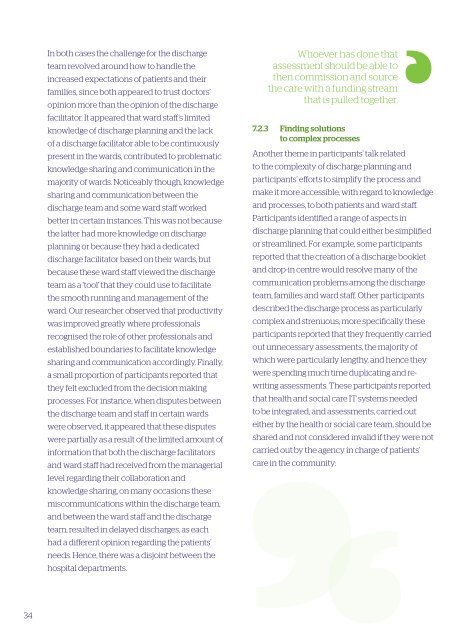Hospital Discharge
3Jzx309Yruj
3Jzx309Yruj
Create successful ePaper yourself
Turn your PDF publications into a flip-book with our unique Google optimized e-Paper software.
In both cases the challenge for the discharge<br />
team revolved around how to handle the<br />
increased expectations of patients and their<br />
families, since both appeared to trust doctors’<br />
opinion more than the opinion of the discharge<br />
facilitator. It appeared that ward staff’s limited<br />
knowledge of discharge planning and the lack<br />
of a discharge facilitator able to be continuously<br />
present in the wards, contributed to problematic<br />
knowledge sharing and communication in the<br />
majority of wards. Noticeably though, knowledge<br />
sharing and communication between the<br />
discharge team and some ward staff worked<br />
better in certain instances. This was not because<br />
the latter had more knowledge on discharge<br />
planning or because they had a dedicated<br />
discharge facilitator based on their wards, but<br />
because these ward staff viewed the discharge<br />
team as a ‘tool’ that they could use to facilitate<br />
the smooth running and management of the<br />
ward. Our researcher observed that productivity<br />
was improved greatly where professionals<br />
recognised the role of other professionals and<br />
established boundaries to facilitate knowledge<br />
sharing and communication accordingly. Finally,<br />
a small proportion of participants reported that<br />
they felt excluded from the decision making<br />
processes. For instance, when disputes between<br />
the discharge team and staff in certain wards<br />
were observed, it appeared that these disputes<br />
were partially as a result of the limited amount of<br />
information that both the discharge facilitators<br />
and ward staff had received from the managerial<br />
level regarding their collaboration and<br />
knowledge sharing, on many occasions these<br />
miscommunications within the discharge team,<br />
and between the ward staff and the discharge<br />
team, resulted in delayed discharges, as each<br />
had a different opinion regarding the patients’<br />
needs. Hence, there was a disjoint between the<br />
hospital departments.<br />
Whoever has done that<br />
assessment should be able to<br />
then commission and source<br />
the care with a funding stream<br />
that is pulled together.<br />
7.2.3 Finding solutions<br />
to complex processes<br />
Another theme in participants’ talk related<br />
to the complexity of discharge planning and<br />
participants’ efforts to simplify the process and<br />
make it more accessible, with regard to knowledge<br />
and processes, to both patients and ward staff.<br />
Participants identified a range of aspects in<br />
discharge planning that could either be simplified<br />
or streamlined. For example, some participants<br />
reported that the creation of a discharge booklet<br />
and drop-in centre would resolve many of the<br />
communication problems among the discharge<br />
team, families and ward staff. Other participants<br />
described the discharge process as particularly<br />
complex and strenuous; more specifically these<br />
participants reported that they frequently carried<br />
out unnecessary assessments, the majority of<br />
which were particularly lengthy, and hence they<br />
were spending much time duplicating and rewriting<br />
assessments. These participants reported<br />
that health and social care IT systems needed<br />
to be integrated, and assessments, carried out<br />
either by the health or social care team, should be<br />
shared and not considered invalid if they were not<br />
carried out by the agency in charge of patients’<br />
care in the community:<br />
34


